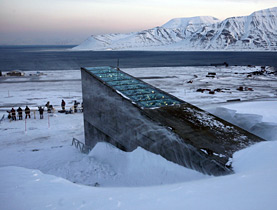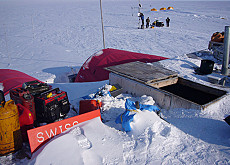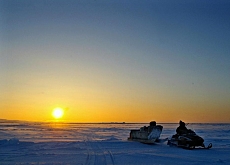Possible clue to life found in Arctic Ocean

Scientists have discovered so-called "black smokers" – strange underwater volcanic chimneys - in a far-northern region of the icy Arctic Ocean.
Two Swiss researchers from Zurich’s Federal Institute of Technology were part of an international team that found the hydrothermal vents, which could provide clues to the origins of life.
The vents, thought to be the most northerly ever identified, are on the Mid-Atlantic Ridge between Greenland and Norway.
State-of-the-art remote underwater technology allowed the Norwegian-led team to take photographs and collect samples from the vents, named Loki’s Castle after a Norwegian god.
The cluster of chimneys are located 73 degrees north, 2,400 metres below the surface of the Arctic Ocean.
Discovered only 30 years ago, “black smokers” are towers of rock that form along the edges of mid-ocean ridges and churn out torrents of scalding water and dissolved minerals from the Earth’s crust which form a black “smoke”. Some scientists believe that these inky superheated, mineral-rich waters may have been ideal places for life to evolve.
Black smokers have previously been found on the Pacific, Atlantic and Indian Ocean floors, but little is known about the Arctic environment.
Significant find
The discovery of Loki’s Castle in mid-July is highly significant, Tamara Baumberger, a mineralogist from the Federal Institute of Technology, told swissinfo.
“This is the world’s most northerly black smoker hydrothermal vent field discovered up to now,” she said.
The cluster of five vents – one towering nearly four stories high – is spewing water as hot as 300 degrees Celsius.
It is located in an area where new oceanic crust is being slowly created and volcanic activity is supposed to be low. Fields of hydrothermal vents are expected to be less common in these conditions.
“Loki’s Castle provides potential answers to questions like the reactions between rocks, sediments, and fluids at ultraslow spreading ridges, and the evolution of the ecosystem -hopefully giving clues about the origins of life,” added Baumberger.
Mats of bacteria
Dissolved sulphide minerals that solidify when vent water hits the icy cold of the deep sea have, over the years, accumulated around the newfound vent field in what is one of the most massive such deposits ever found on the seafloor, said expedition member Marvin Lilley.
The vents are created where the seafloor spreads apart. The farther north one goes along the ridge, the slower the spreading is.
“We hadn’t expected a lot of active venting on ultra-slow spreading ridges,” said the University of Washington oceanographer.
The active chimneys in the new field are mostly black and covered with white mats of bacteria feasting on the minerals emitted by the vents.
The whole deposit is about 825 feet in diameter at its base and about 300 feet across on the top and might turn out to be the largest such deposit seen on the seafloor, Lilley said.
Unique ecosystem
Hydrothermal vents, and the rich variety of chemicals they emit, support one of the most unique ecosystems on the planet – animals and plants living in complete darkness, under huge pressure, deep under water.
Without energy from the sun, these deep-sea species survive on a unique form of chemical energy. At the base of the food chain are chemosynthetic bacteria.
Unlike plants, which derive energy from the sun, these microbes feed on chemicals like sulphuric acid and carbon dioxide that come up through the hot springs from deep inside the Earth. The bacteria in turn become the basic nutrients for tubeworms and other animals higher up the food chain.
“Preliminary observations suggest that the ecosystem around these Arctic vents is different from vent communities found elsewhere,” said Baumberger.
“The hot and anaerobic environment and the fluid chemistry of present-day hydrothermal systems is likely to be similar to the environments where early life could have evolved. But how these ecosystems form is not yet fully understood,” she added.
Baumberger and her supervisor, Gretchen Bernasconi-Green, will now continue their research looking at the chemical reactions between the rock, sediment and seawater and, together with colleagues from the Centre for Geobiology at the University of Bergen, Norway, will analyse how the ecosystem’s micro-organisms function.
swissinfo, Simon Bradley
A black smoker is a type of hydrothermal vent found on the ocean floor. They are formed when superheated water from below the Earth’s crust comes through the ocean floor. This water is rich in dissolved minerals from the crust, notably sulphides. When it comes in contact with cold ocean water, many minerals precipitate, forming a black chimney-like structure around each vent. The metal sulphides that are deposited can become massive sulphide ore deposits over in time.
Black smokers were first discovered in 1977 on the East Pacific Rise near the Galapagos Islands. They are known to exist in the Atlantic, Pacific and Indian Oceans, at an average depth of 2,100 metres. The most northerly black smokers are a cluster of five named Loki’s Castle, discovered in mid-July 2008 by scientists at 73 degrees north, on the Mid-Atlantic Ridge between Greenland and Norway.
The water in a vent can reach temperatures of up to 400 degrees Celsius, but does not usually boil at the seafloor level. The water is also extremely acidic, often having a pH value as low as 2.8 — similar to vinegar.

In compliance with the JTI standards
More: SWI swissinfo.ch certified by the Journalism Trust Initiative




You can find an overview of ongoing debates with our journalists here . Please join us!
If you want to start a conversation about a topic raised in this article or want to report factual errors, email us at english@swissinfo.ch.